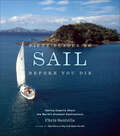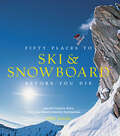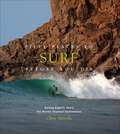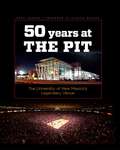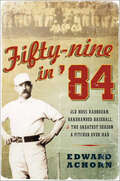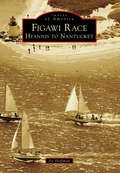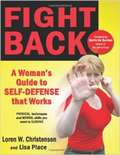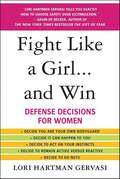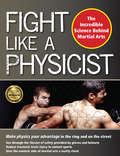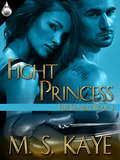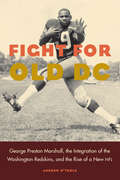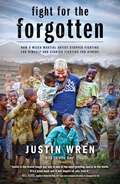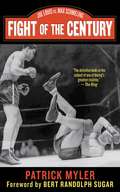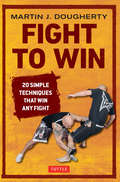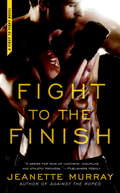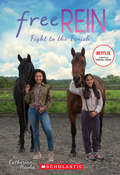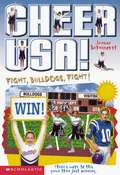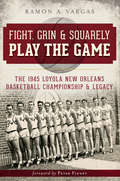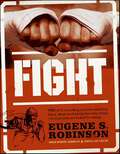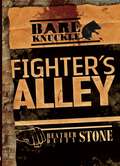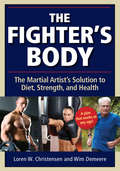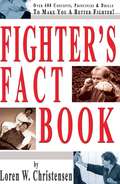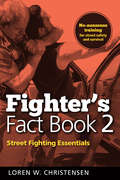- Table View
- List View
Fifty Places to Sail Before You Die: Sailing Experts Share the World's Greatest Destinations (Fifty Places)
by Chris SantellaChampionship racers and professional adventurers disclose their favorite destinations in an inspiring volume of stories, travel tips, and photos. Featuring some of the best-known men and women in the sport—Tom Whidden and Gary Jobson (members of the winning 1987 America&’s Cup crew), Jeff Johnstone (of J-Boats), award-winning sailing writer Lin Pardey, and many others—this is a unique full-color celebration for sailors to relive their greatest memories or plan their next big adventure. The amazingly diverse places they&’ve selected include: Australia: Fremantle and Sydney Bermuda: St. George&’s Harbor Brazil: Bay of Ilha Grande California: Channel Islands and San Francisco Bay Chile: Cape Horn Italy: Costa Smeralda, Sardinia Maine: Boothbay Harbor, Penobscot Bay, Southwest Harbor Florida: Biscayne Bay and Key West Scotland: Firth of Clyde South Africa: Cape Town…and dozens more For each place, the sailor recommending the venue spins an entertaining yarn about their experience there, and each description is accompanied by a &“make you want to go there now&” photograph. From the relative indolence of cruising the Dodecanese or the British Virgin Islands, to the white-knuckle adventure of rounding Cape Horn, to the thrill of partaking in the regatta off Newport, Fifty Places to Sail Before You Die captures the rich and varied world of recreational sailing—and may just inspire you to set sail on some new adventures of your own.
Fifty Places to Ski & Snowboard Before You Die: Downhill Experts Share the World's Greatest Destinations (Fifty Places)
by Chris Santella Matt HansenClimb every mountain—and ski and snowboard the world&’s most amazing slopes, from Aspen to Zermatt. Includes color photos. Based on interviews with leading experts, Fifty Places to Ski and Snowboard Before You Die chronicles the rich history of these sports and the people who&’ve mastered them, including Tommy Moe, Jonny Moseley, Billy Kidd, and Greg Harms, and takes you to the fabulous mountains you&’ve visited—or have always wanted to visit. Explore the world&’s most inspiring skiing and snowboarding destinations: Chugach Mountains (Alaska) * Aspen, Crested Butte, and Steamboat Springs (Colorado) * Tuckerman Ravine (New Hampshire) * Rusutsu (Japan) * Chamonix (France) * Portillo (Chile) * Whistler Blackcomb (British Columbia) * Mammoth Mountain and Squaw Valley (California) * Kashmir (India) * Taos (New Mexico) Jay Peak, Mad River Glen, Stowe (Vermont) * Jackson Hole (Wyoming) * and more! Chris Santella brings to life the gorgeous scenery, the glamorous ambience, and the always-thrilling experience of visiting mountains from the Alps to the Rockies, whether it&’s après-ski in Cortina or helicopter rides into virgin Alaskan powder. If you&’re jetting off on your next getaway or just armchair-traveling this season, this guide will inspire beginners and black-diamond experts alike.
Fifty Places to Surf Before You Die: Surfing Experts Share the World's Greatest Destinations (Fifty Places)
by Chris SantellaCovering famed surf spots all over the world, this unique full-color gift book and travel guide invites you to discover such unexpected gems as the Amazon and the Gulf of Alaska. From the frigid waters off Iceland’s Reykjanes Peninsula to Nazaré, Portugal, where in 2013 Garrett McNamara broke a world record for surfing the tallest wave (78 feet!), highlights also include: North Shore, Oahu, Hawaii Gold Coast, Australia Malibu, California Faroe Islands, Denmark Cocoa Beach, Florida Hossegor, France Grajagan, Indonesia Montauk, New York Thurso, Scotland Jeffreys Bay, South Africa And dozens more! Fifty Places to Surf takes readers on a wide-roving adventure, divulging the details that make each venue unique—and plenty of tips for those who aspire to surf there. Author Chris Santella writes in his introduction, “Surfing means different things to different people. For some it might mean longboarding mellow chest-high waves in board shorts, followed by a great sushi dinner; for others it may mean donning a six-millimeter wetsuit to brave near-freezing waters and triple overheads. Fifty Places to Surf Before You Die attempts to capture the spectrum of surfing experiences—from beginner-friendly to downright death-defying.” Featuring interviews with seasoned surfing experts such as pro surfer Joel Parkinson and Billabong executive Shannan North, Fifty Places to Surf Before You Die is an essential travel companion for surfers of all levels who are looking to catch that perfect wave.
Fifty Years at the Pit: The University of New Mexico's Legendary Venue
by Gary HerronBasketball fans at the University of New Mexico have always been loyal, loud, and numerous, and the devotees have grown in number over the fifty years since the opening of the University Arena, a.k.a. the Pit, in 1966. Herron recounts many of the best players and games in this celebration of one of the best-known facilities in the United States.With almost two hundred color photographs, this illustrative explosion shows you the players, the plays, the coaches, and the sold-out crowds dressed in red. You can recall the colorful nicknames: Petie Gibson, Marvin &“Automatic&” Johnson, and, of course, &“Stormin&’ Norman&” Ellenberger. This stunning work also contains extensive statistics that will not disappoint—like who took the Lobos to the most postseason contests.Herron does not overlook women&’s basketball, a standout sport at UNM, nor does he omit the great non-UNM entertainment that has happened at the Pit: the NMAA state high school basketball tournament, the Gathering of Nations, boxing matches, bull riding, concerts, and more.
Fifty-Nine in '84: Old Hoss Radbourn, Barehanded Baseball, & the Greatest Season a Pitcher Ever Had
by Edward AchornFifty-nine in ’84 is award–winning journalist Edward Achorn’s riveting history of late nineteenth century baseball and the era’s most legendary pitcher.In 1884, Providence Grays pitcher Charles "Old Hoss" Radbourn won an astounding fifty-nine games—more than anyone in major-league history ever had before, or has since. He then went on to win all three games of baseball's first World Series.Fifty-nine in ’84 tells the dramatic story not only of that amazing feat of grit but also of big-league baseball two decades after the Civil War—a brutal, bloody sport played barehanded, the profession of uneducated, hard-drinking men who thought little of cheating outrageously or maiming an opponent to win.Wonderfully entertaining, Fifty-nine in ’84 is an indelible portrait of a legendary player and a fascinating, little-known era of the national pastime.“A beautifully written, meticulously researched story about a bygone baseball era that even die-hard fans will find foreign, and about a pitcher who might have been the greatest of all time.” —Joseph J. Ellis, Pulitzer Prize–winning historian “First-class narrative history that can stand with everything Steven Ambrose wrote. . . . Achorn's description of the utter insanity that was barehanded baseball is vivid and alive.” —Boston Globe
Figawi Race: Hyannis to Nantucket
by Joe HoffmanWhen three friends gathered at Baxter's Boathouse in 1972 to discuss their Memorial Day weekend plans over a few beers, none of them would have suspected that they were on the verge of creating one of the prestigious sailing events on the Atlantic coast. The Figawi Race began as a challenge among a group of sailing enthusiasts who wanted to see who could race their boat to Nantucket first. After the first race, in which Bob "Red" Luby beat out brothers Bob and Joe Horan, it was decided by Bob Horan that it should become an annual event. In 1973, there were 15 boats, and the Figawi Race was off and running. The race evolved into a three-day event complete with a New England clambake. Figawi Race: Hyannis to Nantucket shares photographs and stories of a race that for over 40 years has continued to bring friends and sailors together.
Fight Back: A Woman's Guide to Self-Defense that Works
by Loren W. Christensen Lisa PlaceSome 'experts' say that you should be submissive when attacked at home or by a stranger. You won't find that advice here, although you might use it as a ruse before you claw your assailant's eyes and annihilate his groin. Your ultimate goal is to get away but you don t achieve that by being meek and docile. You get away by drawing on that hard-wired survival instinct to attack him like an enraged lioness protecting its babies. In Fight Back: A Woman's Guide to Self-defense that Works, martial arts experts Loren W. Christensen and Lisa Place teach you to use your hands, forearms, elbows, teeth, knees and feet to survive the type of attack that unsuspecting women become the victims of every day. And you will learn that you're surrounded by a limitless cache of weapons that you can use to your advantage against a larger assailant. If you're ready to learn to fight back, Loren and Lisa know exactly what you need to survive an attack in your home or on the street.
Fight Like a Girl
by Sheena KamalThe Beauty of the Moment meets Exit, Pursued by a Bear. Award-winning thriller writer Sheena Kamal delivers a kick-ass debut YA novel that will have fans crying out for more.Love and violence. In some families they're bound up together, dysfunctional and poisonous, passed from generation to generation like eye color or a quirk of smile. Trisha's trying to break the chain, channeling her violent impulses into Muay Thai kickboxing, an unlikely sport for a slightly built girl of Trinidadian descent. Her father comes and goes as he pleases, his presence adding a layer of tension to the Toronto east-end townhouse that Trisha and her mom call home, every punch he lands on her mother carving itself indelibly into Trisha's mind. Until the night he wanders out drunk in front of the car Trisha is driving, practicing on her learner's permit, her mother in the passenger seat. Her father is killed, and her mother seems strangely at peace. Lighter, somehow. Trisha doesn't know exactly what happened that night, but she's afraid it's going to happen again. Her mom has a new man in her life and the patterns, they are repeating.
Fight Like a Girl . . . and Win: Defense Decisions for Women
by Lori Hartman GervasiA kick-ass practical guide that packs a major punch ... without even throwing one! Self-defense lecturer and no-nonsense blonde bombshell Lori Gervasi lays out simple actions and important decisions women must make BEFORE they find themselves in physical danger to eliminate surprise and panic.It's an unfortunate reality that women are susceptible to random acts of aggression, from sexual harassment and stalking to physical assaults, domestic violence, date rape and worse. But women can learn how to protect and defend themselves -- with this groundbreaking guidebook. Let martial arts black belt and accomplished journalist Lori Hartman Gervasi walk you through easy-to-follow, everyday steps for taking charge of your personal safety, training your reflexes, and -- if and when the time comes -- using force. Her program consists of 26 potentially life-saving decisions that every woman must make, including:DECIDE TO BELIEVE IN YOUR FIGHT – Battles are waged from the inside out. Your conscience, intelligence, and guts must be committed to the cause. You and those you love are the things worth fighting for. DECIDE TO DEVISE A STRATEGY – Create a one-way ticket out of every imaginable circumstance, from back-door escape routes to getaways in public places. Think "what-if…?", plan for the unexpected, and be ready for anything! DECIDE TO RECOGNIZE THE THREAT OF THE INITIAL ATTACK – When practicing awareness, you can detect danger before it happens. The bad guy will take steps to get close to you. Watch carefully and identify these for what they are—the preludes to an attack. DECIDE TO MOVE – If an attacker strikes, don't freeze—get moving! Break through your fear with instant mobility. You have limitless options and any movement works as long as it leads to your safety. DECIDE TO ACTON YOUR INSTINCTS – Your intuition is your guide, but you must respond physically in order to be successful. When something isn't right, take action, change plans, redirect yourself, and control your destiny! …along with Defense Do's And Don'ts, inspiring "Power Points," and other survival tactics that can help you to be prepared, stay strong, and FIGHT LIKE A GIRL…AND WIN
Fight Like a Physicist: The Incredible Science Behind Martial Arts
by Jason ThalkenCRUSHES MYTHS. UTTERLY BRILLIANT! An in-depth look into the physics behind martial arts Whether you are an experienced martial artist or a curious enthusiast, this book gives you an "unfair advantage" by unraveling the complex science of effective fighting techniques and examining the core principles that make them work. Did you know? * Momentum is for knocking people over * Energy is for breaking bones and causing pain * A haymaker travels 3.14159 times farther than a jab * You are only an "object" when you are rigid Fight Like a Physicist blends inquiry, skepticism, and irreverent humor--all while punching holes in myth and mysticism. Highlights include * Making physics your "unfair advantage," in the ring and on the street * Examining center of mass, pi, levers, wedges, angular momentum, and linear momentum for martial artists * Reducing traumatic brain injury in contact sports * Exposing the illusion of safety provided by gloves and helmets * Overturning conventional wisdom on compliance during an assault * Busting up Hollywood action clichés Fight Like a Physicist reads like a manifesto on the rational practice of martial arts. It's intelligent, fun, and dangerous--and nothing short of iconoclastic.
Fight Princess
by M. S. KayeA murderer is on the loose, and if Celisse isn't careful, she could be his next victim. In a race against time, Celisse investigates the crime, searching for the clues that link the murder, an underground fight ring, and the man who raises the most passionate feelings in her. M.S. Kaye pens a hot, sexy, suspenseful romance in Book 1 of her Full Contact series, Fight Princess.Things aren't what they seem. Don't get involved.Celisse is too headstrong to listen. Her best friend's boyfriend is dead, and she does not heed Cullen's warning, slipped to her in a note as he's being arrested for the murder.Cullen tries to keep Celisse out of danger and also tries to avoid her, both unsuccessfully. He can't deny his feelings for her anymore, but he knows he can't have her. If she ever discovered the truth about his past, she'd surely hate him.While struggling with her intense feelings for Cullen, Celisse uses her skills as an ex-prosecutor to investigate, all while continuing to fight for Ogden, the organizer of an underground fight ring. She eventually realizes things are connected--the ring, Ogden, Cullen, the murder, and herself. She races to uncover the truth before she's arrested or becomes the next victim--or perhaps, the next culprit.Content Notes: Spicy
Fight for Old DC: George Preston Marshall, the Integration of the Washington Redskins, and the Rise of a New NFL
by Andrew O'TooleIn 1932 laundry-store tycoon George Preston Marshall became part owner of the Boston Braves franchise in the National Football League. To separate his franchise from the baseball team, he renamed it the Redskins in 1933 and then in 1937 moved his team to Washington DC, where the team won two NFL championships over the next decade. But it was off the field that Marshall made his lasting impact. An innovator, he achieved many “firsts” in professional football. His team was the first to telecast all its games, have its own fight song and a halftime show, and assemble its own marching band and cheerleading squad. He viewed football as an entertainment business and accordingly made changes to increase scoring and improve the fan experience. But along with innovation, there was controversy. Marshall was a proud son of the South, and as the fifties came to a close, his team remained the only franchise in the three major league sports to not have a single black player. Marshall came under pressure from Congress and the NFL and its president, Pete Rozelle, as league expansion and new television contract possibilities forced the issue on the reluctant owner. Outside forces finally pushed Marshall to trade for Bobby Mitchell, the team’s first black player, in 1962. With the story of Marshall’s holdout as the backdrop, Fight for Old DC chronicles these pivotal years when the NFL began its ascent to the top of the nation’s sporting interest.
Fight for the Forgotten: How a Mixed Martial Artist Stopped Fighting for Himself and Started Fighting for Others
by Justin WrenFrom notable mixed martial artist and UFC fighter Justin Wren comes a personal account of faith, redemption, empowerment, and overwhelming love as one man sets out on an international mission to fight for those who can’t fight for themselves.Justin knows what it feels like to be wronged. Bullied as a child, he dreamed of becoming a UFC fighter and used his anger as fuel to propel his dream into reality. But the pain from his childhood didn’t dissipate. Instead, Justin fell into a spiral of depression and addiction, leading him on a path toward destruction. Kicked out of his training community and with no other place to go, Justin agreed to attend a men’s retreat, and it was there he found God. As Justin began piecing his life back together, he joined several international mission trips that opened his eyes and his heart to a world filled with suffering deep in the jungle of the Democratic Republic of Congo. There he met the Mbuti Pygmy tribe, a group of people persecuted by neighboring tribes and forced into slavery. His encounter with the Pygmy tribe left him wondering who was there to help them and in that moment Justin stepped out of the ring and into a fight for the forgotten. From cage fighter to freedom fighter, Justin’s story is a deeply personal memoir with a bigger message about a quest, justice, and the amazing things that can happen when we relinquish our lives to God.
Fight of the Century: Joe Louis vs. Max Schmeling
by Patrick Myler"The definitive book" (The Ring) on one of the greatest sports events of the twentieth century, the heavyweight championship bout between America's "Brown Bomber," Joe Louis, and Germany's Max Schmeling.More than the world heavyweight championship was at stake when Joe Louis fought Max Schmeling on June 22, 1938. In a world on the brink of war, the fight was depicted as a contest between nations, races, and political ideologies, the symbol of a much vaster struggle. Nazi propaganda minister Joseph Goebbels boasted that the Aryan Schmeling would crush his "inferior" black opponent. President Roosevelt told Louis, his guest at the White House, that "America needs muscles like yours to beat Germany." For Louis, this was also his chance to avenge the only loss in his brilliant career-by a knockout-to the same Max Schmeling two years earlier.Recreating the drama of their momentous bout, the author traces the lives of both fighters before and after the fight, including Schmeling's efforts in Nazi Germany to protect Jewish friends and the two boxers' surprising friendship in the postwar years. In Fight of the Century Myler tells the story of two decent men, drawn together by boxing and divided by the cruel demands of competing nations.
Fight to Win
by Martin J. DoughertyFight to Win strips self-defense and street fighting tactics down to the basics, presenting a uniquely effective fighting system with a minimum of technical jargon and maximum effect.Martin J. Dougherty holds three black belts and has spent more than two decades training championship fighters in many discipline. Dougherty is committed to teaching men and women of all skill levels and incorporates specialized programs tailored to the physically disadvantaged and those with disabilities. Drawing upon his broad-based expertise, Dougherty presents twenty simple fighting techniques guaranteed to give the you the advantage in any fight . Learn such famed techniques as the: Hammerfist, the Two-Legged Takedown, and the Triangle Choke. Whether used in competition or on the street, these fighting techniques are virtually unbeatable. In addition to step-by-step photos, Fight to Win offers easy-to-follow instructions and additional notes on combat psychology and tactics to help you hone a fighter's instincts. Fight techinques include:How to Attack the Human BodyBasic Takedown DefenseGroundfighting positionsStriking TechniquesLeg TakedownsTactical ConsiderationsBecause if you're going to fight, fight to win.
Fight to Win
by Martin J. DoughertyFight to Win strips self-defense and street fighting tactics down to the basics, presenting a uniquely effective fighting system with a minimum of technical jargon and maximum effect.Martin J. Dougherty holds three black belts and has spent more than two decades training championship fighters in many discipline. Dougherty is committed to teaching men and women of all skill levels and incorporates specialized programs tailored to the physically disadvantaged and those with disabilities. Drawing upon his broad-based expertise, Dougherty presents twenty simple fighting techniques guaranteed to give the you the advantage in any fight . Learn such famed techniques as the: Hammerfist, the Two-Legged Takedown, and the Triangle Choke. Whether used in competition or on the street, these fighting techniques are virtually unbeatable. In addition to step-by-step photos, Fight to Win offers easy-to-follow instructions and additional notes on combat psychology and tactics to help you hone a fighter's instincts. Fight techinques include:How to Attack the Human BodyBasic Takedown DefenseGroundfighting positionsStriking TechniquesLeg TakedownsTactical ConsiderationsBecause if you're going to fight, fight to win.
Fight to the Finish
by Jeanette MurrayThe author of Against the Ropes takes her First to Fight series another round with a novel of a JAG officer who loses his cool, when love delivers a knockout punch... Kara is a single mom working hard to keep life running smoothly for herself and her son, but a custody battle is wearing her down. When her friend suggests asking a JAG officer for some unofficial advice, Kara agrees--and soon finds herself officially head over heels... As a Judge Advocate, Graham has seen his share of nasty custody disputes--and he plans on keeping his distance from this one. But this purposeful, passionate woman has a way of drawing him ever closer to the edge. And when Kara's ex starts to throw his weight around, Graham will have to choose between toeing the line or stepping into the ring...
Fight to the Finish (Free Rein #2)
by Catherine HapkaAn original novel based on the hit Netflix show!The one and only Poppy Addison is headed to Bright Field Stables! Poppy, a famous rider, is hosting an exclusive clinic at Bright Fields. There will be a contest to award a free spot to a Bright Fields rider. Zoe is sure that she and her horse, Raven, can blow Poppy and the other judges away! There's just one problem: Jade wants to win, too. With two best friends competing and only one winner, this contest may be a recipe for a total friendship fiasco. Includes an 8-page insert packed with photos from the TV show!
Fight, Bulldogs, Fight! (Cheer USA #2)
by Jeanne BetancourtIt's time for the big football game between the Claymore Bulldogs and their legendary rivals, the Cougars. As the rivalry heats up, some of the pranks get out of hand...
Fight, Grin and Squarely Play the Game: The 1945 Loyola New Orleans Basketball Championship and Legacy (Sports)
by Peter Finney Ramon A. VargasIn 1945, the Loyola New Orleans Wolf Pack became the city's first basketball team to earn a national championship. The Cinderella season was chronicled in the "Times Picayune," the student newspaper "The Maroon" and letters from students and alums fighting overseas. The 1944-45 run to the championship was an amazing boon to the community during trying times. The group of boyhood friends and rivals beat out previous national champions and exhausted opponents. Take a courtside seat as journalist Ramon A. Vargas chronicles the season, including heartfelt personal narratives to tell the story of the championship and legacy of a team that led Loyola to national prominence.
Fight: Everything You Ever Wanted to Know About Ass-Kicking but Were Afraid You'd Get Your Ass Kicked for Asking
by Eugene S. RobinsonCrushing your enemies, driving them before you, and hearing the lamentations of their women? It doesn't get any better than this." –Eugene Robinson, ripping off John Milius That's the sentiment that surges just below the surface of Eugene Robinson's Fight – an engrossing, intimate look into the all–absorbing world of fighting. Robinson – a former body–builder, one–time bouncer, and lifelong fight connoisseur – takes readers on a no–holds–barred plunge into what fighting is all about, and what fighters live for. If George Plimpton had muscles and had been choked out one too many times––this is the book he could have written. When Robinson and his fellow fighters mix it up, they live completely for the moment: absorbed in the feel of muscles slippery with sweat; the metallic tang of blood mingling with saliva in the mouth; the sweet, firm thud of taped knuckles impacting flesh. They fight because it feels good. They fight because they want to win. And even if they get their asses kicked, they fight because they love fighting. Fight is part encyclopedia, part panegyric to fighting in all its forms and glory. Robinson's narrative – told in his trademark tough–guy, stream–of–consciousness noir voice – punctuates this explanatory compendium of the fighting world. From wrestling, jiu–jitsu, boxing and muay thai to bar fighting, hand–to–hand combat, prison fighting and hockey fights, from the greatest movie fight scenes to how to throw the perfect left hook, Fight is a scene–by–scene tour of the bloody but beautiful underworld that is the art of fighting. With his aficionado's enthusiasm and fast–paced, addictive voice, Robinson's Fight combines compelling text with beautiful photographs to create an illustrated book as edgy and interesting as it is gorgeous.
Fighter's Alley (Bareknuckle)
by Heather Duffy StoneWill's father is running for mayor. The competition is slim. So all Will has to do is keep from embarrassing his family during the election. Problem is, Will has been secretly boxing down at the Woodrat Club—just the sort of seedy place Will's dad wants to stomp out. After training with Eddie Tancredi, a mysterious ex-boxer, Will enters a high-stakes Woodrat tournament. He even has a shot at victory. But will his family conflict ruin his chances? If not, secrets from Eddie’s past might . . .
Fighter's Body: The Martial Artist's Solution to Diet, Strength, and Health
by Loren W. Christensen Wim DemeereYou have an owner's manual for your car, your stereo, and even your blender, so why not your body? The Fighter's Body is exactly that--an owner's manual for your most complex piece of equipment.As a martial artist, you make special demands of your body. Have you ever wondered how that latest fad diet might affect your performance on the mat? Ever wanted to take off a few extra pounds? How about putting on muscle without slowing down? Making weight for a tournament? Losing five pounds fast? Eating better? Changing weight classes? Are you confused about supplements, vitamins, and protein shakes? Don't know where to start? Start here.This book will answer your questions about important topics including* Why some diets are harmful for martial artists * How to calculate your protein needs for training* When and how to use supplements* How to eat at fast food places and not ruin your diet* Why it's OK to splurge on "dirt day"* How to safely make weight for a tournament* Why HIIT training is essential to weight loss* What to eat on competition days* How to create a plan that works and stick to itLoren W. Christensen and personal trainer Wim Demeere combine their knowledge of martial arts, weight training, nutrition, diet, and exercise to answer your questions and put you on the road to becoming the best martial arts athlete you can be.
Fighter's Fact Book
by Loren W. ChristensenWith over 35 years experience in the ring, on the mat and in the street, Loren Christensen understands the daily challenges faced by martial artists. In this book he has put together a collection of over 400 tips, drills, principles, concepts and exercises to give you the edge no matter what style of martial art you practice. Discover quick and innovative ways to improve your punching, kicking, sparring and self-defence skills plus dozens of tips to work those hard to improve areas like speed, power and flexibility. If you are feeling stuck or bored in your martial arts routine, Loren's down-to-earth, in-your-face-style will get you up and training with a fire you have not felt in years. With hundreds of training methods drawn from his vast experience, research and interviews with top instructors around the country, Loren has put together an essential reference for every martial arts student and instructor.
Fighter's Fact Book 2: Street Fighting Essentials
by Loren W. ChristensenNo-nonsense training for street safety and survivalYou will fight how you train. That's why Fighter's Fact Book 2 presents a critical look at training and real-world applications. When you've mastered the skills taught in this book, you will truly be ready to defend yourself in some of the most desperate situations imaginable.You will learn how to defend yourself against multiple assailants, violent dogs, and knife attacks. You'll learn how to contend with close-quarters attacks and adversaries who are impervious to pain. You'll also get no-nonsense instruction on fighting wounded and the justified use of extreme tactics.Loren W. Christensen shares lessons from his decades of martial arts training and law enforcement experience. He has also enlisted a host of expert contributors:* Lt. Col. Dave Grossman* Iain Abernethy* Rory Miller* Kris Wilder* Lawrence Kane* Alain Burrese* Wim Demeere* Richard Dimitri* Mark Mireles* Tim Delgman* Dan AndersonThese men are proven survivors, and their multidisciplinary analyses will change the way you see training and fighting.The authors will show you how to make your street techniques fast and explosive, and how to prepare yourself mentally to use extreme force. These skills are not for the faint of heart. They are hardcore techniques intended to save your life or the life of a loved one.
